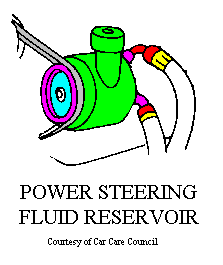PROPER CARE
Checking Your Power Steering Fluid
*VERY EASY*
The power steering fluid can be checked with the engine either hot or cold. Check your power steering fluid every month according to the following procedure:
- Be certain the engine has reached operating temperature. Turn the steering wheel right and left a few times to release any air bubbles that may be in the system. Place the front wheels in a straight position. Park the vehicle on level ground with the engine OFF, the parking brake engaged, and the transmission in PARK (for automatic) or REVERSE (for manual). Raise the hood.
- Locate the power steering fluid reservoir using your owner's manual. The
reservoir and belt-driven pump are combined into one unit. It is usually on the
front left (driver's) side of the engine.
Wipe any dirt off the exterior surfaces, especially the filler cap and neck, to prevent fluid contamination. Check for fluid leaks at the hose connections or reservoir. If leaks are discovered, have them repaired by a professional automotive technician. - Twist the filler cap counterclockwise and remove it. Some caps may resist removal due to the airtight rubber seal; still pull firmly. Wipe the attached dipstick on clean rag. Insert it again into the reservoir neck and firmly seat the cap. Remove the filler dipstick and hold it horizontally or upright to read, but not upside-down (this may permit power steering fluid to drip towards the FULL HOT or MAX mark, giving a false reading). Read the fluid level. Repeat a second time for confirmation. The fluid level should be at, but not above, the FULL HOT (or MAX) mark.
- Check the color and condition of the fluid; it should be clear or golden
in color.
If it has a dark beige or brown tint, it has reached the end of its useful life. The heat and pressure in the system have depleted the fluid additives and perhaps thickened the fluid. It must be changed in this situation. If left unattended, it will deteriorate the rubber hoses and become black. In such a case, the fluid and hoses should be completely changed. - As a second test, wipe some fluid on a dark rag or towel. If shiny metallic particles appear, the fluid should also be completely changed. These abrasive particles from the steering gears could further damage the steering system if left in the fluid.
- If the level is too low, add some extra power steering fluid as necessary and in small amounts through the reservoir neck. Use a clean, wide-mouthed funnel to avoid spilling fluid on other components of the engine. Recheck the fluid level after reinserting the dipstick. Use the power steering fluid recommended in your owner's manual. The fluid specification can usually be found on the power steering reservoir cap as well. On some cars, the specified fluid is simply automatic transmission fluid. If too much fluid is added, it must be removed through the filler neck using a siphon tube or rubber squeeze bulb. Tighten the filler cap in clockwise direction.
- The power steering fluid level can also be checked with a cold engine. The level shown on dipstick should be at the FULL COLD (or MIN) mark, but not below. Add extra fluid if needed.
It is not necessary to flush and change the power steering fluid unless the fluid is worn or contaminated.


